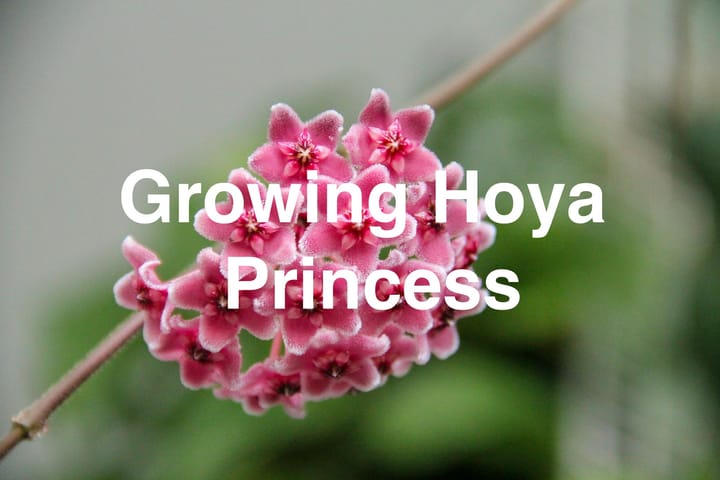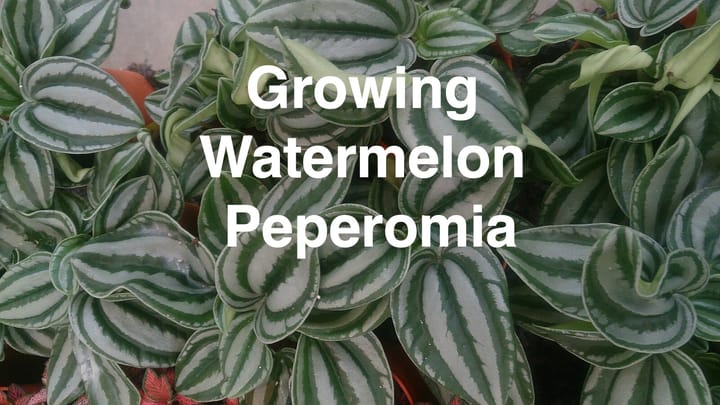How to Grow Air Plant
Air plants, known scientifically as Tillandsia, offer a unique and low-maintenance option for indoor gardening. Unlike traditional plants, they don't require soil to grow, deriving their nutrients from the air and water around them.
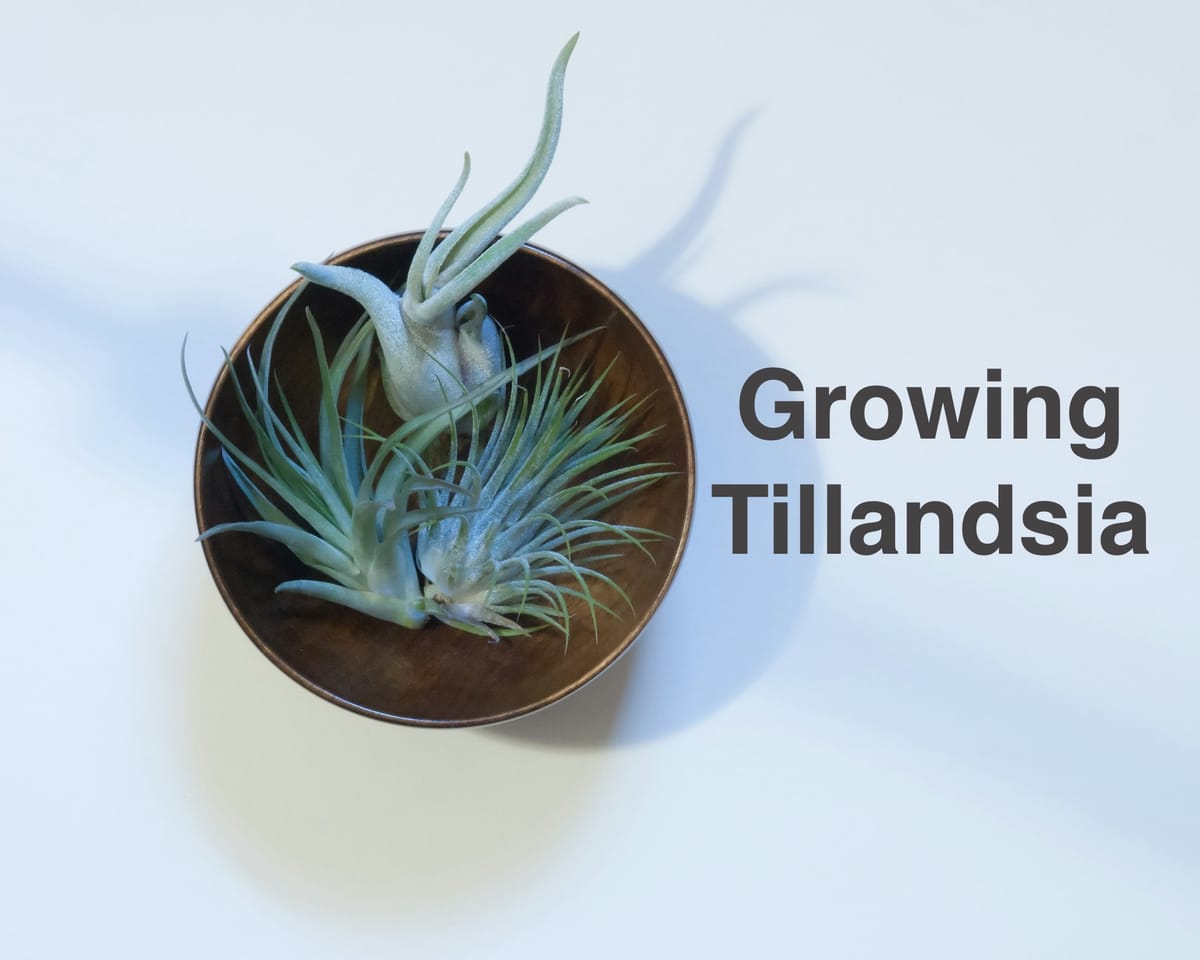
This distinctive feature makes them versatile and easy to display in a variety of creative ways, such as in terrariums, on pieces of driftwood, or simply hanging in the air.
Caring for air plants begins with understanding their watering needs.
Regular watering is essential, and the preferred method involves soaking the plants for about 20 to 30 minutes each week, which mimics the rainfall of their natural habitats.
After soaking, it's important to allow the plants to dry completely to prevent rot.
With the right balance of water, light, and air circulation, air plants can thrive and even produce offsets, known as pups, allowing you to expand your collection over time.
Key Takeaways
- Air plants need no soil to grow, relying on airborne and waterborne nutrients.
- Soak air plants weekly for optimal hydration, followed by a thorough drying.
- Proper care encourages air plants to thrive and reproduce through pups.
Understanding Air Plants
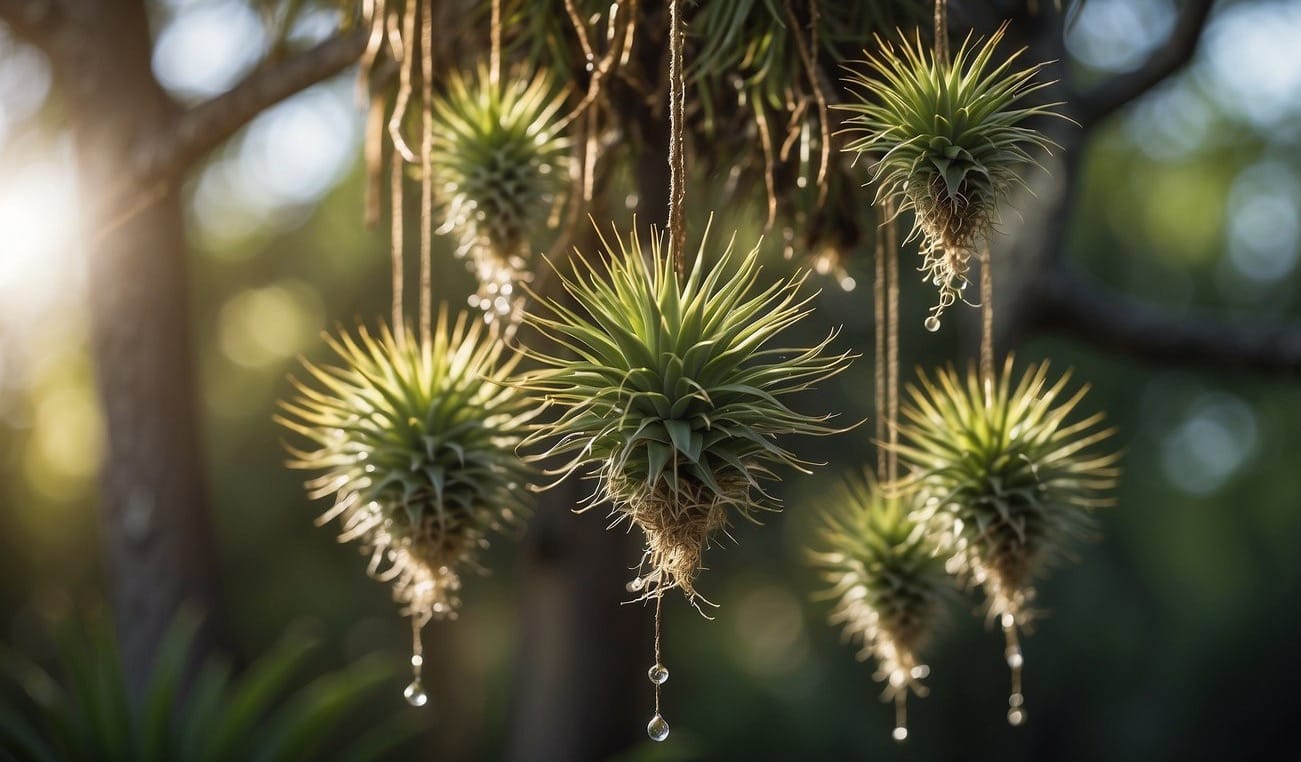
In this exploration of air plants, you'll acquire insights into the diverse varieties, discover their natural habitats, and understand what sets these unique plants apart from their soil-reliant counterparts.
Varieties of Air Plants
The genus Tillandsia, commonly referred to as air plants, encompasses around 650 species. They belong to the family Bromeliaceae and range in size, shape, and color.
Notable species include Tillandsia ionantha, prized for its vibrant bloom, and Tillandsia usneoides, also known as Spanish moss, which drapes gracefully from tree branches.
The Natural Habitat
Air plants are typically found as epiphytes, meaning they grow on other plants or hosts non-parasitically.
Their habitats are diverse, spanning the southern United States, Mexico, Central America, and South America.
These plants thrive in environments from rainforests to arid deserts, relying on their surroundings for moisture and nutrients.
What Makes Air Plants Unique
Air plants are distinguished by their ability to absorb water and nutrients through their leaves rather than roots.
Their leaves are covered with trichomes, specialized cells which serve as their primary means of sustenance.
As epiphytes, air plants don't require soil, allowing them to grow in a variety of locations, including suspended in air.
Getting Started with Air Plants
Air plants, or Tillandsias, are intriguing houseplants that thrive without soil, opening up new possibilities for display and decor.
Understanding how to select and supply for your air plant will ensure a healthy beginning for your growing adventure.
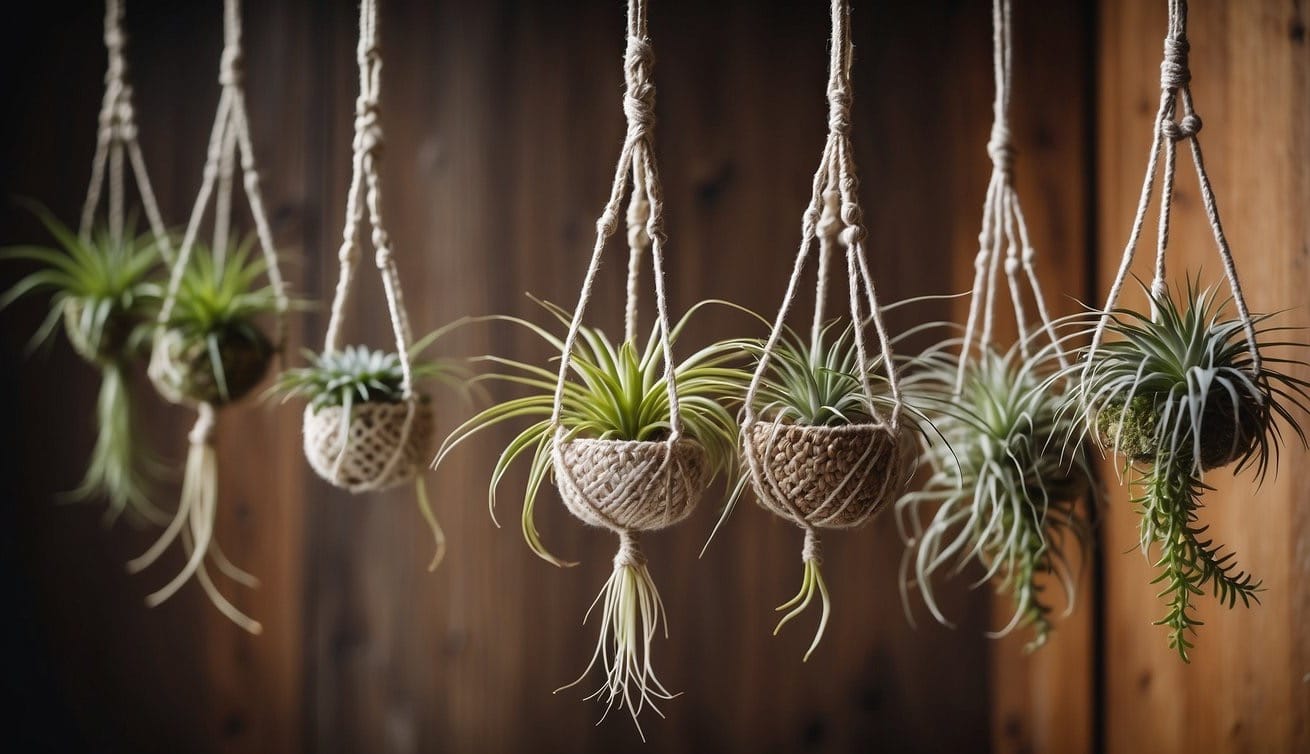
Selecting Your Air Plant
When choosing your air plant, consider the size, shape, and color you prefer as these plants come in a wide variety.
Look for healthy, green specimens and inquire about varieties to understand their specific sunlight and watering needs.
It's worth noting that some air plants produce offsets, or pups, after flowering, which will eventually grow into mature plants.
Essential Supplies
To care for your air plant effectively, a few supplies are necessary:
- Watering container: A bowl or sink to soak your plants, ensuring thorough hydration.
- Trimming Shears: For pruning or harvesting pups when they mature.
- Display Holders: Consider wire holders, shells, or hanging glass terrariums for creative displays.
- Fertilizer: Specialty air plant fertilizers are available to provide the necessary nutrients.
- Misting bottle (optional): Some prefer to mist their plants between soakings for extra humidity.
Regular soaking and proper air circulation will contribute to the health and longevity of your air plants, setting the foundation for a rewarding growing experience.
The Basics of Air Plant Care
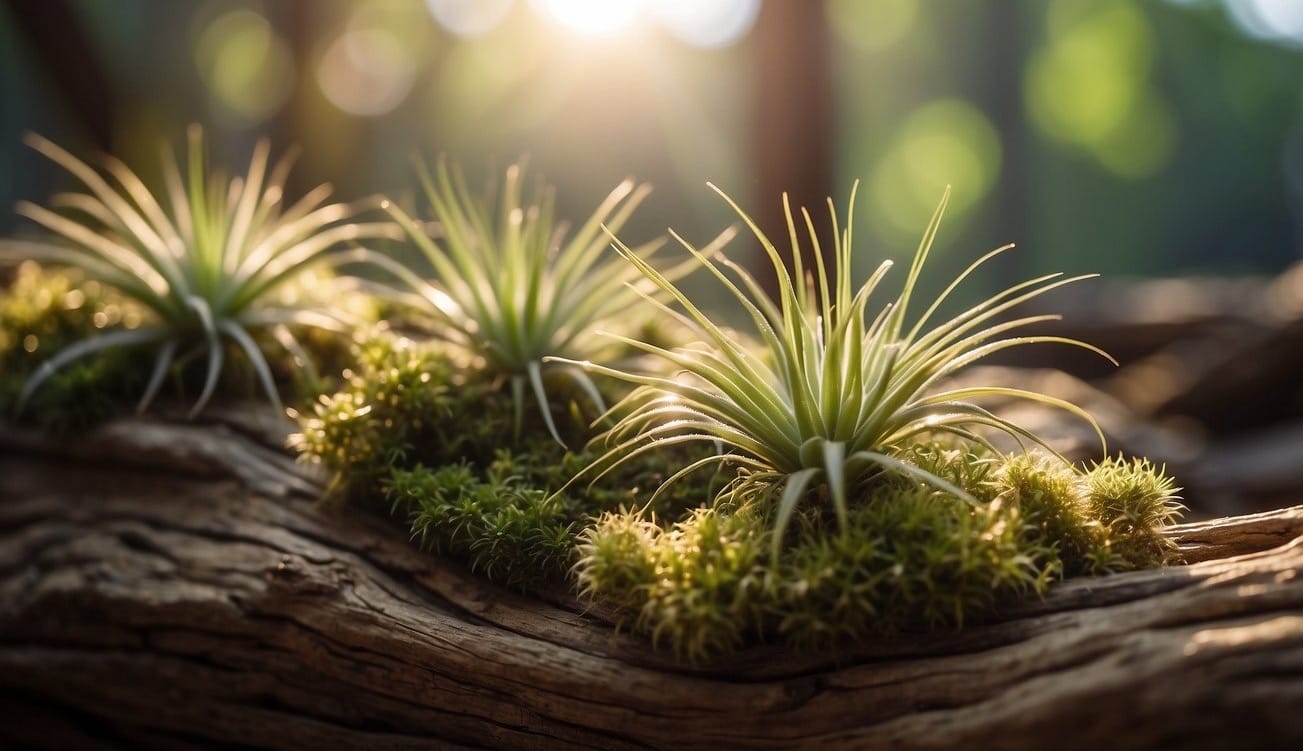
Caring for your air plant involves managing three key aspects: lighting, temperature, and humidity. Each factor plays a significant role in their overall health and vigor.
Proper Lighting
Air plants prefer bright, indirect light. Place your air plants near a window where they can receive plenty of light, but avoid direct sunlight that can scorch their leaves.
A north-facing window is typically ideal, providing enough light without the harsh intensity of direct sun.
- Optimal Light Condition: Bright, indirect light
- Avoid: Prolonged exposure to direct sunlight
Maintaining Temperature
Air plants thrive in a temperature range that is comfortable for most people, typically between 60-80°F (16-27°C).
They can tolerate brief dips outside of this range, but prolonged exposure to cold or heat can damage them.
Ensure that your air plants are kept away from drafts and sources of heat like radiators or air conditioners.
- Ideal Temperature Range: 60-80°F (16-27°C)
- Protect from: Extreme heat and cold drafts
Ensuring Adequate Humidity
These tropical plants love humidity. Your air plant will benefit from a high humidity environment, ideally between 50-70%.
In drier climates, you can increase humidity by misting your plants or placing them in a bathroom, where they can absorb moisture from showers and baths.
- Humidity Level: 50-70%
- Hydration Tips: Misting or soaking in room-temperature water for 20-30 minutes every 1-2 weeks. Always allow the plant to dry completely to avoid rot.
Watering and Fertilizing
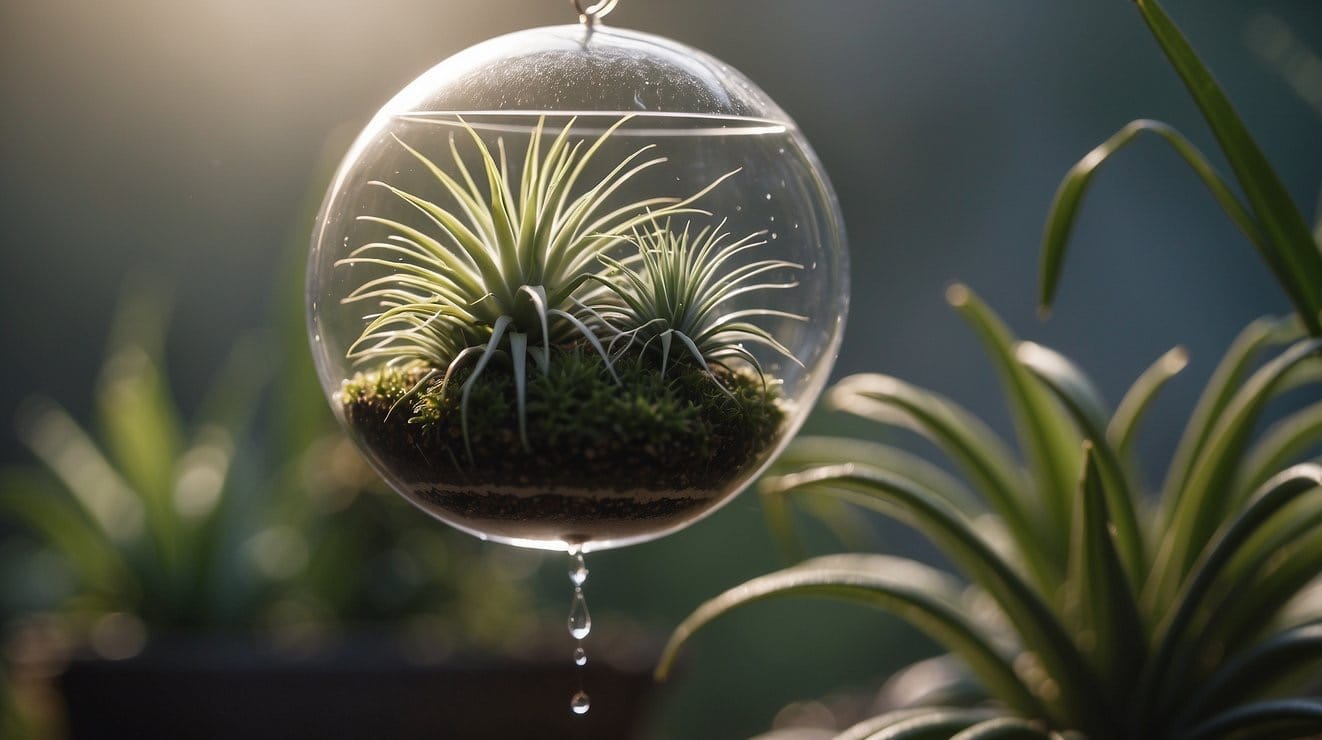
Air plants thrive with the right balance of watering and fertilizing. While they don’t need soil, their unique maintenance is essential for health and growth.
How Often to Water Air Plants
You should water your air plants once a week, although requirements can vary based on humidity and air circulation in your environment.
During the hotter months, you might need to increase watering frequency.
Techniques for Watering
Soaking is a preferred method for hydrating your air plants.
Submerge the plant in a bowl of spring water or filtered water for 20-40 minutes every one to two weeks.
After soaking, shake off excess water and allow them to dry completely.
Misting can supplement moisture between soaks, especially in drier conditions.
Using Fertilizer Wisely
Fertilizer should be applied sparingly to air plants.
A monthly application of a specific bromeliad or air plant fertilizer during the growing season is enough.
Mix the fertilizer with water and apply it using the spray method or add it to your soaking routine. In winter, you can reduce or skip fertilization.
Display and Mounting Techniques

Air plants (Tillandsia) offer versatile display options and don't require soil, which allows you to get creative with how and where you display them.
Here's how to showcase air plants in your space effectively.
Creative Display Ideas
Terrariums: You can use glass globes or terrariums for a modern appearance. Place a layer of moss, stone, or decorative sand at the bottom, and position your air plants within.
- Driftwood and Tree Branches: Secure your air plants to a piece of driftwood or distinct tree branches for a naturalistic look. Ensure they are firmly attached but not too tightly to avoid damaging the plants.
- Cork and Coral: Utilize pieces of cork or coral as a base for mounting air plants. These materials can help create a unique oceanic or woodland theme.
- Shells and Slate: For a maritime vibe, consider using large seashells. Alternatively, slate pieces can serve as a sleek, minimalist platform for your air plants.
Mounting Air Plants
Materials: To attach an air plant to your chosen display medium, you can use a non-toxic adhesive, fishing line, or even wire. Be gentle to avoid harming the plant.
- Cork or Wood: Simply apply a small amount of adhesive to the base of your air plant and press it onto the cork or wood. Wait for it to dry completely before hanging or displaying.
- Non-porous Surfaces: For attachments to materials like glass or ceramics, fishing line is discreet and holds the plant well without damaging it. Wrap it gently and secure it in place.
Propagation and Repotting
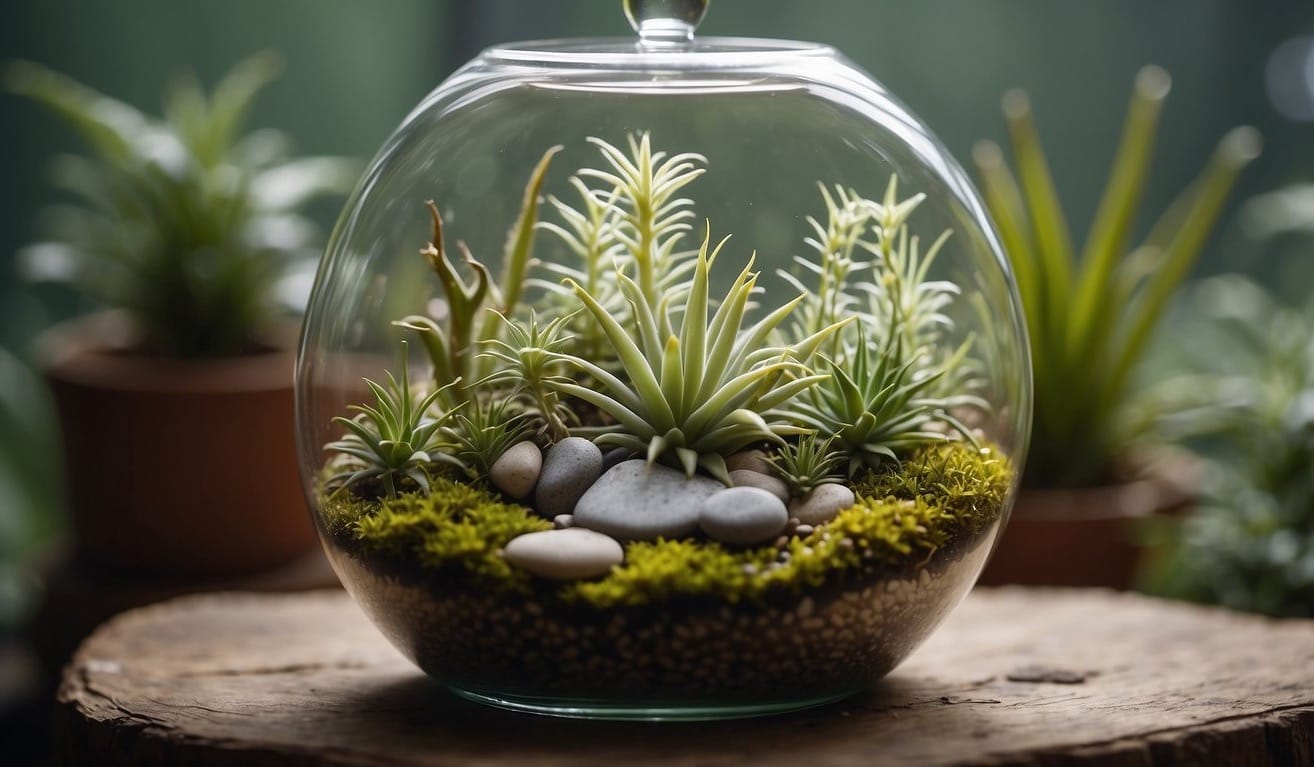
Propagation is a natural process that allows you to cultivate new plants from an existing one.
In air plants, this is typically done through offsets or pup production, with repotting being unnecessary due to their soil-less nature.
Understanding Propagation
Air plants reproduce by producing pups, which are small offsets that grow at the base of the parent plant.
Once these pups reach about one-third the size of the parent plant, they can be safely removed and grown independently.
During this phase, ensure you maintain adequate light and moisture conditions to encourage healthy growth.
It's important to note that pups are the most common way to propagate air plants and they represent exact genetic replicas of the parent plant.
How to Propagate Air Plants
To propagate air plants through pups, follow these steps:
- Identify the Pups: Look for small plants forming at the base of the parent plant.
- Separation:
- Wait until the pup is at least one-third the size of the parent plant.
- Gently hold the parent plant and the pup, twisting them in opposite directions to separate. Make sure not to damage the plants.
Tip: If the pup does not come away easily, use clean, sharp scissors to snip it free. Take care not to cut into the pup itself.
Another method of propagation is through seeds, although this process is more time-consuming and less commonly used:
- Seed Collection: Harvest seeds from a mature air plant after it has flowered.
- Seed Propagation:
- Soak the seeds in water for a brief period to stimulate germination.
- After soaking, place them on a suitable growing medium.
- Maintain a humid environment and wait for germination, which can take weeks to months.
Propagation through cuttings is less common in air plants as it applies more to plants with larger, branch-like structures.
Nonetheless, if you have an air plant with a suitable stem, you can:
- Use a sterile blade to take a cutting of about 4 to 5 inches long.
- Allow the cut end to callus over for a day before setting it up for rooting.
Troubleshooting Common Problems

When growing air plants, you may encounter issues such as pest invasions or environmental stress that can affect the health of your plants. Identifying and managing these problems early is crucial to ensure your air plants thrive.
Pest and Disease Management
Pests: Your air plants may fall prey to pests like mealybugs and scale insects. Both present differently; mealybugs as tiny white creatures, and scale as bump-like formations on the leaves. To manage these pests:
- Inspect your plants regularly for early signs of infestation.
- Use a cotton swab dipped in isopropyl alcohol to remove pests on sight.
Diseases: Overwatering can lead to rot, where the plant may start to appear brown or black and feel mushy. To prevent and address rot:
- Ensure air plants dry completely after watering.
- Avoid letting water sit in the crevices of the plant, as this can harbor fungal growth.
Dealing with Environmental Stress
Light: Air plants can suffer from too much or too little light. Signs of distress from inadequate light are paler leaves, while too much light can cause burn, evident from browned or scorched areas on the leaves.
- Position your plants in bright, indirect light, adjusting for the type of air plant you have.
- Monitor the color and texture of your plants' leaves to gauge if the light levels are appropriate.
Humidity and Dryness: Air plants require a certain level of humidity to prosper. Environments that are too dry can deplete the plants, making it tough for them to bloom and maintain healthy leaves.
- To manage humidity, mist your air plants several times a week.
- In dryer climates, consider more frequent misting or using a humidity tray.
Seasonal Air Plant Care Tips

Maintaining the right balance of light, temperature, and moisture is essential for the thriving of your air plants (Tillandsia) throughout the year. Here's how to adjust their care with the change of seasons.
Summer Care
During summer, ensure your air plants receive bright indirect light as direct sunlight can scorch their leaves.
Aim for a temperature range between 70°F to 85°F (21°C to 29°C), which is an ideal climate for Tillandsia.
High temperatures necessitate increased humidity and watering frequency.
Watering might be needed more than once a week, but always ensure the plants are dry within four hours after soaking to prevent rot.
- Light: Bright, indirect sunlight
- Temperature: Comfortable household temperatures, avoid AC vents
- Watering: Increase frequency due to higher temperatures and humidity
- Humidity: Aim for a 60% humidity level if possible
Winter Care
In winter, the temperature and indoor heating can reduce the ambient humidity, so your air plants may need less water.
Keep your plants in a place where they can get ample indirect light and away from cold drafts and heaters.
The ideal temperature range during the winter is 50°F to 70°F (10°C to 21°C). If your home gets very dry, occasional misting can help provide necessary moisture.
- Light: Sufficient indirect light
- Temperature: Cooler but not cold, generally above 50°F (10°C)
- Watering: Less frequent, allowing the plant to dry thoroughly between watering
- Humidity: Supplement with misting if the air is too dry
Frequently Asked Questions
In this section, you'll find common inquiries about growing and caring for air plants, ensuring you have the essential knowledge to maintain these unique flora.
What are the ideal conditions for indoor air plant care?
Your indoor air plants flourish under bright, indirect light and need to be placed in a warm and humid environment. Keep them away from prolonged direct sunlight to prevent leaf scorch.
What are the basic requirements for beginners starting with air plants?
Beginners should use a shallow container of room-temperature water for soaking, ensuring your air plants get enough light and air circulation. They should water their air plants by submerging them for 20-30 minutes weekly.
How can air plants be propagated from seeds?
To propagate from seeds, provide optimal growing conditions including the right balance of light, temperature, and humidity.
Germination can take from a few weeks up to several months, during which you’ll see sprouting and development of roots.
Is it possible to grow air plants in containers, and if so, how?
Yes, you can grow air plants in containers. Use containers that allow for ample air flow and do not retain water, and be sure they are not planted in soil. Glass globes, mesh, or wire forms are excellent choices.
What is the proper technique for watering air plants to ensure their health?
Submerge your air plants in water for 20-30 minutes, shake off excess water gently, and place them upside down to dry completely. This watering routine should typically be followed on a weekly basis.
Can air plants thrive without soil and how should they be displayed?
Air plants do not need soil to survive. They absorb moisture and nutrients through their leaves.
Display them in a manner that allows for good air circulation. Mounted on wood, nestled in shells, or suspended in the air are popular choices.
